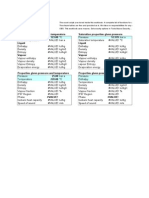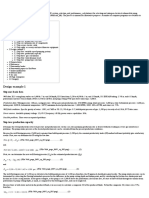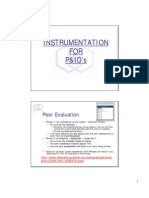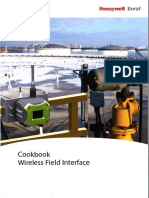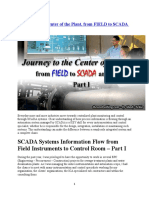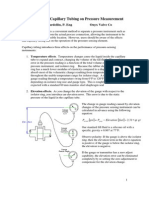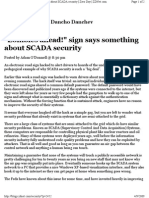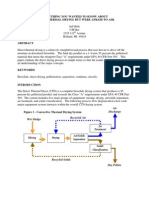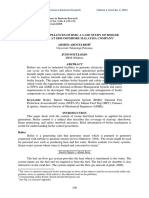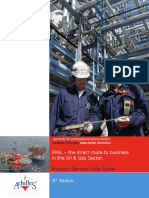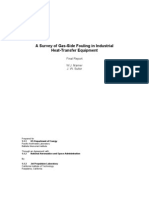Siemens Draft Range Pressure Installation Recommendations ADSITRPDS3-1r1
Siemens Draft Range Pressure Installation Recommendations ADSITRPDS3-1r1
Uploaded by
Anonymous zdCUbW8HfCopyright:
Available Formats
Siemens Draft Range Pressure Installation Recommendations ADSITRPDS3-1r1
Siemens Draft Range Pressure Installation Recommendations ADSITRPDS3-1r1
Uploaded by
Anonymous zdCUbW8HfCopyright
Available Formats
Share this document
Did you find this document useful?
Is this content inappropriate?
Copyright:
Available Formats
Siemens Draft Range Pressure Installation Recommendations ADSITRPDS3-1r1
Siemens Draft Range Pressure Installation Recommendations ADSITRPDS3-1r1
Uploaded by
Anonymous zdCUbW8HfCopyright:
Available Formats
Siemens Energy & Automation
APPLICATION DATA
ADSITRPDS3-1
Rev 1 May 2005
Draft Range Pressure Measurement
BACKGROUND
While the term draft range pressure lacks a precise definition, it is generally recognized as a gauge or differential pressure less than 5.0" H2O. Often these are non-zero-based spans, the most common range being - 0.1" H2O to 0.3" H2O for furnace atmospheric pressures. Draft pressure measurement controls or protects many different processes in various markets from heat treating to power utilities. Draft pressure transmitters and higher range pressure transmitters have the same major requirements: accuracy, stability, and reliability. The sensitivity, stability and inherent accuracy of the silicon sensor in the DSIII line of pressure transmitters make it ideally suited for these applications. However, selecting a high performance draft transmitter is only half the battle. Installation details that at higher pressures can be overlooked become a major source of error at very low draft pressures. This paper discusses various draft pressure transmitter applications and processes and later provides application and installation tips.
APPLICATIONS AND PROCESSES
Below are several applications and processes that require draft range transmitters. Air Flow The objective here is to accurately measure the low differential pressure (DP) generated by the flow of air or gas through primaries such as pitot tubes, averaging pitot tubes, orifice plates, and venturis. These flow primaries are known as square law devices because the flow is proportional to the square root of the DP developed by the device. Some examples of applications that require flow measurement follow.
FT FT FT
Venturi Tube
Pitot Tube
Orifice Plate
DRAFT RANGE PRESSURE MEASUREMENT
Boilers Air flow into a boiler is measured with an averaging pitot tube or venturi to control fuel-air ratio. Waste gases that are a result of boiler operation can also be measured with a pitot tube or averaging pitot tube. Furnaces Fuel or cover gas flow into a furnace can be measured with any of the devices mentioned, selection depending upon the accuracy required.
Pressure Drop Measurement of the DP across devices such as air heaters, precipitators, scrubbers, and other filter-type elements is performed to determine when they require service. An example of an application follows: Boilers To maximize efficiency, we measure the pressure drop across parts of a boiler that can build up soot or ash (e.g., air heaters, scrubbers, economizers, and precipitators) to determine when maintenance is needed.
DPT DPT DPT
Various Filter Elements
Pressure It is often necessary to measure the gauge pressure in devices such as boilers, heat treat furnaces, glass furnaces, reheat furnaces, and soaking pits. Several applications follow: Boilers To assure efficient operation and complete combustion, we measure the gauge pressure in the interior of a boiler furnace in order to keep it slightly negative (typically -0.25" H2O) by controlling the boiler inlet or outlet dampers. Furnaces A slight positive pressure (typically +0.1" H2O) is required in most thermal market furnaces. This assures good fuel economy and efficient use of cover gas through control of the damper in the furnace stack.
PT Boiler Furnace
PT
Furnace Stack
DRAFT RANGE PRESSURE MEASUREMENT
APPLICATION AND INSTALLATION TIPS
Transmitter Mounting A transmitters orientation and mounting can be critical in draft pressure measurement. There are two main points to remember: the transmitter must be rigidly mounted and the mounting must not be affected by environmental conditions (e.g. heat, vibration, shock). A SITRANS P Model 7MF4433 DP transmitter is calibrated at the factory with the process diaphragms perpendicular to the ground. This orientation is shown in the center transmitters in the two figures below. Rotation from this orientation can cause a zero-shift, depending on the direction of rotation. In the top figure, the center transmitter is rotate 90 left and right but the diaphragm remains perpendicular to the ground so there is no zero-shift. However, in the lower figure, when the center transmitter is re-orientated from the vertical, as shown by the left and right transmitters, a zero-shift is induced because the diaphragm changes from perpendicular to the ground to parallel. Maximum zero-shift is about 1.5" H2O occurring when the process diaphragms are parallel to the ground. At higher pressures this may not be critical, but at draft pressures it can be significant. For example, a 1" H2O shift on a 0.4" H2O span is a 250% error!
+ +
+ +
Diaphragm Plane for these three orientations
MG00362a
No Change in Diaphragm Orientation
Diaphragm Plane
Diaphragm Plane
Diaphragm Plane
MG00362a
Diaphragm Orientation Changes
Zero-shift is easily eliminated either during bench test or after installation using the magnetic pushbuttons on the SITRANS P 1. During a bench test, the transmitter can be oriented in its final mounting position and then calibrated. If the transmitter is already installed, simply correct for Zero position error using the
PDM software and a HART-based hand-held are options available for transmitter calibration and configuration
DRAFT RANGE PRESSURE MEASUREMENT
pushbuttons to select transmitter Operating Mode 7 (Set Zero Position Correction). Zero correction must be performed with a stable zero differential across the transmitter pressure inputs. A draft transmitter must be rigidly mounted. A change in transmitter orientation due to temperature variations, bumps, vibration, etc. can cause a zero-shift; see the figure below. Note that even a minimal 0.001" H2O shift represents a 0.25% error at a span of 0.4" H2O. For this reason, use the supplied bracket to mount the transmitter to a wall, I-beam, or pipe that is not likely to vibrate or to be bumped and will remain stable in spite of ambient temperature changes. A zero-shift error introduced by transmitter orientation can easily be zeroed out, but the varying effects of an unstable mounting can not be corrected by recalibrating the transmitter.
+
MG010000
Stable Mounting
Unstable Mounting
Impulse Piping Measurement errors can occur when good practice is not followed during impulse pipe installation. For example, impulse pipe must be installed such that no unwanted liquid or gas can accumulate in the transmitter process flange cavity. In draft pressure applications, the process fluid is usually air or gas so care must be taken to prevent any accumulation of liquid (e.g., condensate) in the impulse piping to the transmitter. Always mount the transmitter above the process connections and slope all horizontal runs to the process downward at one inch per foot. This will prevent liquid from accumulating at the transmitter.
DRAFT RANGE PRESSURE MEASUREMENT
Low Pressure Side
Transmitter ABOVE Orifice, For Gas Flow
High Pressure Side
Model 7MF4433 or 7MF4533 3-Valve Manifold
Flow
When the process fluid is a liquid, mount the transmitter below the process connections with all horizontal runs to the process sloped upward at one inch per foot. This will prevent air or gas from accumulating at the transmitter.
Flow
Low Pressure Side
Transmitter BELOW Orifice, For Liquid
High Pressure Side
Model 7MF4433 or 7MF4533 3-Valve Manifold
DRAFT RANGE PRESSURE MEASUREMENT
Gauge Pressure Measurement Often draft pressure measurements will be straight gauge pressure applications as opposed to true DP applications. In these situations the Low Pressure (LP) port of the differential transmitter must be vented to atmosphere. This should not be done by simply leaving the port unconnected because air flowing past the open LP port (from heating and cooling fans, natural wind currents, traffic, etc.) will cause a slight vacuum resulting in measurement errors. The solution is to pipe the LP port as shown below. Vent the open end of this pipe into a still air chamber which is vented to atmosphere. The still air chamber can be as simple as a one gallon milk jug. Another solution is to put a porous sponge, like that used for an air filter, around the end of the LP pipe. Other techniques will also work. The goal is to have a stable reference to atmosphere that is unaffected by air currents.
MG010000
MG010000
Air Filter Sponge
Still Air Chamber
DRAFT RANGE PRESSURE MEASUREMENT
Capsule Heating Uneven radiant heating can cause draft pressure transmitter errors. The SITRANS P 7MF4433 is a twodiaphragm, balanced, fluid filled system. The fill has a known thermal expansion coefficient that is included in transmitter compensation. However, if one side of the capsule is heated differently than the other, measurement errors will occur; see the following two figures.
+
+ +
Heat Radiating Equipment
Heat Radiating Equipment
MG010000
Process Inputs Even Capsule Heating
Process Inputs Uneven Capsule Heating
Identify and protect the transmitter from possible sources of radiant heating when selecting a mounting location for a draft transmitter. These sources include boilers, furnaces, heaters, ovens and even the sun. If the source of heat can not be eliminated, mount the transmitter so that the capsule is evenly heated by the source, as shown in the above left figure. Accuracy A transmitter can be ranged using your plant-standard pressure source and transmitter Operating Modes 2 and 3 (Set Zero and Set Full Scale respectively) to set up zero and full scale. Alternatively, range the transmitter using the blind method and Operating Modes 5 and 6 (Set Zero Blind and Set Full Scale Blind respectively). Both procedures are described in the Users Manual 2. If the accuracy of the plantstandard pressure source is insufficient, the blind method may offer optimal accuracy. Static Pressure Effects In some applications, very low pressures are measured at high static pressures. Maximum performance can be obtained by calibrating the transmitter to remove any zero-shift due to mounting position and static pressure at the same time. This should be done with the transmitter in its final position, with the static pressure applied, and with zero DP across the transmitter.
Refer to UMSITRPDS3-1, Users Manual SITRANS P, Series DSIII Transmitter for Pressure, Differential Pressure, Flanged Level, and Absolute Pressure Model 7MF4*33-
DRAFT RANGE PRESSURE MEASUREMENT
CONTACT INFORMATION Telephone Fax E-mail Hours of Operation Public Internet Site Repair Service +1 800 569 2132, option 2 +1 215 283 6358 mailto:PItechsupp@sea.siemens.com 8 a.m. to 4:45 p.m. eastern time Monday Friday (except holidays) www.sea.siemens.com/ia +1 215 646 7400 extension 3187
NORTH AMERICA
Outside of North America see the Siemens web site at www.sea.siemens.com/ia; locate Customer Support Process Instrumentation and click the Contact Tech Support link to access the Global Support link.
Siemens Energy & Automation, Inc. assumes no liability for errors or omissions in this document or for the application and use of information in this document. The information herein is subject to change without notice. Customers are urged to consult a Siemens Energy & Automation, Process Industries Division sales representative to confirm availability and specifications. Copyright 2005, Siemens Energy & Automation, Inc.
You might also like
- Normal Shut Down ProcedureDocument10 pagesNormal Shut Down ProcedureNandana BinilNo ratings yet
- Caviter PDFDocument12 pagesCaviter PDFstphn_maturinNo ratings yet
- Pressure MeasurementDocument34 pagesPressure Measurementgiskardrev94% (17)
- ST 3000 and SFC User Manual 34-St-32-02d Aug 1993-OcrDocument180 pagesST 3000 and SFC User Manual 34-St-32-02d Aug 1993-OcrAnonymous zdCUbW8Hf100% (1)
- Fluidized Bed Combustion Boiler TechnologyDocument68 pagesFluidized Bed Combustion Boiler TechnologyhexbiNo ratings yet
- Square Edged Orifice MeterDocument3 pagesSquare Edged Orifice Metervijay kumar honnaliNo ratings yet
- High DP Orifice FlowDocument2 pagesHigh DP Orifice FlowtibitomicNo ratings yet
- PSVDocument11 pagesPSVGaurav MishraNo ratings yet
- Steam Drain Calc.Document11 pagesSteam Drain Calc.acckypenrynNo ratings yet
- Hitachi S-4700 InstructionsDocument19 pagesHitachi S-4700 InstructionssuperheoNo ratings yet
- Tutorial Topic 2 2020 RevisedDocument3 pagesTutorial Topic 2 2020 RevisedTara PillayNo ratings yet
- Barometric Pressure Vs AltitudeDocument2 pagesBarometric Pressure Vs AltitudeMahimmay paulNo ratings yet
- Basic Heat Pump ComponentsDocument6 pagesBasic Heat Pump Componentsdrabc123No ratings yet
- Float Board Level GaugeDocument6 pagesFloat Board Level GaugeanaismariaNo ratings yet
- Gas AnalyzerDocument5 pagesGas Analyzerengine5No ratings yet
- P-I Transducer - P200-P290 PDFDocument4 pagesP-I Transducer - P200-P290 PDFman_y2kNo ratings yet
- Pillard - Packlight Buk 117 CDocument2 pagesPillard - Packlight Buk 117 CAlfonso Blanco100% (1)
- Bicolor Color Port Type Level Gauge PDFDocument2 pagesBicolor Color Port Type Level Gauge PDFKaruppuswamy PalanisamyNo ratings yet
- 6850/6890 GC Column Installation and Instrument Setup Guide - PPIP/TCDDocument18 pages6850/6890 GC Column Installation and Instrument Setup Guide - PPIP/TCDWaleed El-azabNo ratings yet
- Dry Scrubber (Approval) PDFDocument12 pagesDry Scrubber (Approval) PDFkrishnaNo ratings yet
- Guid For Air Leak in VacuumDocument4 pagesGuid For Air Leak in Vacuumscranderi100% (1)
- Understanding P&Ids DrawingsDocument3 pagesUnderstanding P&Ids DrawingsajayikayodeNo ratings yet
- Batch Reactor Heating & CoolingDocument1 pageBatch Reactor Heating & CoolinganurkatNo ratings yet
- Physical Properties of FurfuralDocument16 pagesPhysical Properties of Furfuralalice.medeirosNo ratings yet
- 1 3 Vacuum MeasurementDocument8 pages1 3 Vacuum Measurementmanikandaprabhu100% (1)
- Instrumentation in UreaDocument6 pagesInstrumentation in UreaGaurav MishraNo ratings yet
- Energy Performance Assessment of Heat ExchangersDocument22 pagesEnergy Performance Assessment of Heat ExchangersShailesh PatelNo ratings yet
- DMB-19-08-R7 ValveDocument6 pagesDMB-19-08-R7 ValveselvakumarNo ratings yet
- DP LT CalibrationDocument6 pagesDP LT CalibrationkvsangeethNo ratings yet
- Energy Losses in Steam TrapsDocument4 pagesEnergy Losses in Steam TrapsBen MusimaneNo ratings yet
- ESP DesignDocument9 pagesESP DesignEmad JamshidiNo ratings yet
- Design Shell TubeDocument3 pagesDesign Shell TubeAKSHEYMEHTANo ratings yet
- Agitated VesselDocument8 pagesAgitated VesselBharatShethNo ratings yet
- Abu Orf M.M. Centrate Viscosity For Continuous Monitoring of Polymer Feed in Dew Ate Ring Applications 2003Document8 pagesAbu Orf M.M. Centrate Viscosity For Continuous Monitoring of Polymer Feed in Dew Ate Ring Applications 2003fermortaraNo ratings yet
- Venturi MeterDocument11 pagesVenturi MeterPrakein RajNo ratings yet
- Vapor Flow To Equivalent Air Flow Conversion EquationsDocument2 pagesVapor Flow To Equivalent Air Flow Conversion EquationsAnonymous bHh1L1No ratings yet
- Diference Between Restriction Orifice and Orifice PlateDocument6 pagesDiference Between Restriction Orifice and Orifice PlateafshinNo ratings yet
- Evaluate Plant-Wide Safety of Your Interlock SystemDocument14 pagesEvaluate Plant-Wide Safety of Your Interlock SystemnavedscribdNo ratings yet
- CPA 50E Type A RF Dimensional Specifications - May 2013Document1 pageCPA 50E Type A RF Dimensional Specifications - May 2013Karthick RamasubramanianNo ratings yet
- Flow Past A Cylinder: Solved With Comsol Multiphysics 3.5ADocument10 pagesFlow Past A Cylinder: Solved With Comsol Multiphysics 3.5AjosejuanramosNo ratings yet
- Steam Condensation ReportDocument17 pagesSteam Condensation ReportKingsley EdemidiongNo ratings yet
- Ejector User GuideDocument2 pagesEjector User GuidehaseebNo ratings yet
- Ratio Pressure Reducing ValvesDocument4 pagesRatio Pressure Reducing Valveskanem1No ratings yet
- Design and Control of A Vapour Recompression C3 SplitterDocument14 pagesDesign and Control of A Vapour Recompression C3 SplitterZangNo ratings yet
- C65 Capstone Micro TurbineDocument2 pagesC65 Capstone Micro TurbineVíctor PalmaNo ratings yet
- Pump Sizing CalculationDocument22 pagesPump Sizing CalculationShikalgar JuberNo ratings yet
- 67CF Series Filter RegulatorsDocument8 pages67CF Series Filter RegulatorsAlberto CastellanosNo ratings yet
- Vertical Separator SizingDocument2 pagesVertical Separator SizingRAJIV_332693187No ratings yet
- Jet Impingement CoolingDocument9 pagesJet Impingement CoolingDanish AbbasNo ratings yet
- Orifice Calc Gas Rev 0Document1 pageOrifice Calc Gas Rev 0edufragaNo ratings yet
- Ultrasonic Horn DesignsDocument5 pagesUltrasonic Horn DesignssolveaudioNo ratings yet
- Vacuum Pump SizingDocument1 pageVacuum Pump SizingAhmad Saiful AnwarNo ratings yet
- PSV Calculation: Capacity Corection Factor Due To Back Pressure (KB)Document1 pagePSV Calculation: Capacity Corection Factor Due To Back Pressure (KB)syamsudin2006No ratings yet
- Instrumentation FOR P&ID's: Peer EvaluationDocument30 pagesInstrumentation FOR P&ID's: Peer Evaluationnarasimharaja100% (3)
- PRACTICAL DP TransmitterDocument5 pagesPRACTICAL DP TransmitterPATEL SWAPNEELNo ratings yet
- FMC - Desairador VerticalDocument4 pagesFMC - Desairador VerticalFaull JackmanNo ratings yet
- Introduction:-: Training On GET-Instrumentation November 2014 Document Title: Pressure Measurment and Control Code: PIDocument7 pagesIntroduction:-: Training On GET-Instrumentation November 2014 Document Title: Pressure Measurment and Control Code: PISANJAYNo ratings yet
- Measuring and Troubleshooting Compressors Line Temperatures Valve Pressures and Motors AnDocument4 pagesMeasuring and Troubleshooting Compressors Line Temperatures Valve Pressures and Motors AnmhdmkNo ratings yet
- Performance and Dimension RCS OLD MANUAL 8INCH2.PDF NewDocument16 pagesPerformance and Dimension RCS OLD MANUAL 8INCH2.PDF NewJorge A VilalNo ratings yet
- Mit World Peace University, Pune: Hydraulics & Pneumatics Laboratory ManualDocument9 pagesMit World Peace University, Pune: Hydraulics & Pneumatics Laboratory ManualAbhay SinghNo ratings yet
- Module 3Document219 pagesModule 3Sourav PoddarNo ratings yet
- Installation and Operation Instructions For Custom Mark III CP Series Oil Fired UnitFrom EverandInstallation and Operation Instructions For Custom Mark III CP Series Oil Fired UnitNo ratings yet
- Service and Aging of Process Valves 27005824Document74 pagesService and Aging of Process Valves 27005824Anonymous zdCUbW8HfNo ratings yet
- Enraf Cookbook Wireless Interface 4417783Document30 pagesEnraf Cookbook Wireless Interface 4417783Anonymous zdCUbW8HfNo ratings yet
- Control Builder Components Reference EXDOC-XX15-en-110 PDFDocument254 pagesControl Builder Components Reference EXDOC-XX15-en-110 PDFAnonymous zdCUbW8Hf0% (1)
- Honeywell Enraf WFI Service ManualDocument112 pagesHoneywell Enraf WFI Service ManualAnonymous zdCUbW8HfNo ratings yet
- Journey To The Center of The Plant and Back Again - SCADA 1Document10 pagesJourney To The Center of The Plant and Back Again - SCADA 1Anonymous zdCUbW8HfNo ratings yet
- API DC Input SplittersDocument6 pagesAPI DC Input SplittersAnonymous zdCUbW8HfNo ratings yet
- What's On Your ServerDocument8 pagesWhat's On Your ServerAnonymous zdCUbW8HfNo ratings yet
- RTD Tolerance Classes TBRTDTOL-0614Document4 pagesRTD Tolerance Classes TBRTDTOL-0614Anonymous zdCUbW8HfNo ratings yet
- Guide To Industrial Control Systems (ICS) Security - NIST - sp.800-82r2Document247 pagesGuide To Industrial Control Systems (ICS) Security - NIST - sp.800-82r2Anonymous zdCUbW8Hf0% (1)
- Installing Intrinsic Safety Termination Panels and Barriers, EmersonDocument74 pagesInstalling Intrinsic Safety Termination Panels and Barriers, EmersonAnonymous zdCUbW8HfNo ratings yet
- Effect of Capillary Tubing On Pressure Measurement, GardellianDocument3 pagesEffect of Capillary Tubing On Pressure Measurement, GardellianAnonymous zdCUbW8HfNo ratings yet
- FDM R430 Software Installation User GuideDocument70 pagesFDM R430 Software Installation User GuideAnonymous zdCUbW8Hf100% (1)
- Electrical Grid VulnerableDocument2 pagesElectrical Grid VulnerableAnonymous zdCUbW8HfNo ratings yet
- Rules For Applying Remote Diaphragm Seals ABB - Feb10 - P24Document1 pageRules For Applying Remote Diaphragm Seals ABB - Feb10 - P24Anonymous zdCUbW8HfNo ratings yet
- Air Monitoring Combustion Air Power BoilersDocument189 pagesAir Monitoring Combustion Air Power BoilersAnonymous zdCUbW8HfNo ratings yet
- Distribution OrderDocument5 pagesDistribution OrderAnita ŽeljkoNo ratings yet
- BoilerDocument21 pagesBoilerJITHIN PNo ratings yet
- Saic W 2003Document14 pagesSaic W 2003Mohammed IlliasuddinNo ratings yet
- Petcoke Process - Foster Wheeler PDFDocument66 pagesPetcoke Process - Foster Wheeler PDFSenthilkumar PragasamNo ratings yet
- Process Industry Practices P&Id: Pip Pic001 Piping and Instrumentation Diagram Documentation CriteriaDocument30 pagesProcess Industry Practices P&Id: Pip Pic001 Piping and Instrumentation Diagram Documentation Criterialimulsa78No ratings yet
- Proper Boiler Lay-Up Procedures: Intermittent StandbyDocument4 pagesProper Boiler Lay-Up Procedures: Intermittent StandbyelgawadhaNo ratings yet
- CERE 136 Laboratory Report 1Document10 pagesCERE 136 Laboratory Report 1Edison LimbagaNo ratings yet
- Modular Procedural AutomationDocument24 pagesModular Procedural Automationsahil4INDNo ratings yet
- Application of An Efficient Exponential Wide Band Model For The NaturalDocument35 pagesApplication of An Efficient Exponential Wide Band Model For The NaturalperulesNo ratings yet
- Dryer Draft ManuscriptDocument10 pagesDryer Draft ManuscriptJuan David PerezNo ratings yet
- Nfpa 85 Compliances of BMS: A Case Study of Boiler Control at SBM Offshore Malaysia Company Ahmed AbouelrishDocument8 pagesNfpa 85 Compliances of BMS: A Case Study of Boiler Control at SBM Offshore Malaysia Company Ahmed AbouelrishRomel RodriguezNo ratings yet
- (BP Process Safety Series) BP Safety Group-Safe Furnace and Boiler Firing-Institution of Chemical Engineers (IChemE) (2005) PDFDocument86 pages(BP Process Safety Series) BP Safety Group-Safe Furnace and Boiler Firing-Institution of Chemical Engineers (IChemE) (2005) PDFHugh MantaNo ratings yet
- Atmospheric Fluidized Bed Combustion BoilerDocument61 pagesAtmospheric Fluidized Bed Combustion Boilerynilesh94_2849714630% (2)
- Ir Div - Notice Related To Oppositon-Notice PDFDocument422 pagesIr Div - Notice Related To Oppositon-Notice PDFshyam143225No ratings yet
- Ramsbootom Carbon Residue PDFDocument20 pagesRamsbootom Carbon Residue PDFnishanthpobbathiNo ratings yet
- FPAL Product Code GuideDocument53 pagesFPAL Product Code GuideSRARNo ratings yet
- MTOE Calculation: Energy Conservation Table and Sample Calculation For Annual Energy Consumption in Terms of MtoeDocument4 pagesMTOE Calculation: Energy Conservation Table and Sample Calculation For Annual Energy Consumption in Terms of MtoeJoydeep PatraNo ratings yet
- Third Class SampleDocument40 pagesThird Class Sampleshanmugam17No ratings yet
- Pyro-Bloc M Module Manual DD 31052016Document20 pagesPyro-Bloc M Module Manual DD 31052016thoavitNo ratings yet
- A Survey of Gas Side Fouling in Industrial Heat Transfer EquipmentDocument162 pagesA Survey of Gas Side Fouling in Industrial Heat Transfer Equipmentnonemax100% (1)
- Boiler SpecificationDocument13 pagesBoiler SpecificationAbdul BasitNo ratings yet
- Goodman Furnace Troubleshooting Codes 6 BlinksDocument3 pagesGoodman Furnace Troubleshooting Codes 6 BlinksAlanNo ratings yet
- Interthermal HeaterDocument4 pagesInterthermal HeaterDava SutherlandNo ratings yet
- Hydrogen Reformer Furnace Failure PDFDocument10 pagesHydrogen Reformer Furnace Failure PDFJacek100% (1)
- SADC - EnglishDocument5 pagesSADC - EnglishAhmad Bayhaqi100% (1)
- Aux Boiler Fire Case StudyDocument3 pagesAux Boiler Fire Case StudyasNo ratings yet
- TGP-15 Pmi & PmacDocument27 pagesTGP-15 Pmi & PmaciplaruffNo ratings yet
- Saudi Aramco Test Report: Final Inspection/Re-Instatement Punch ListDocument11 pagesSaudi Aramco Test Report: Final Inspection/Re-Instatement Punch ListEswari AnandNo ratings yet








